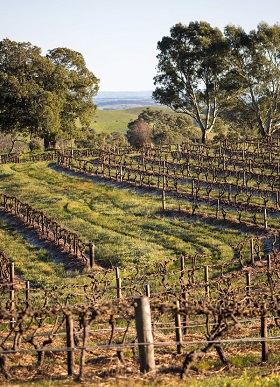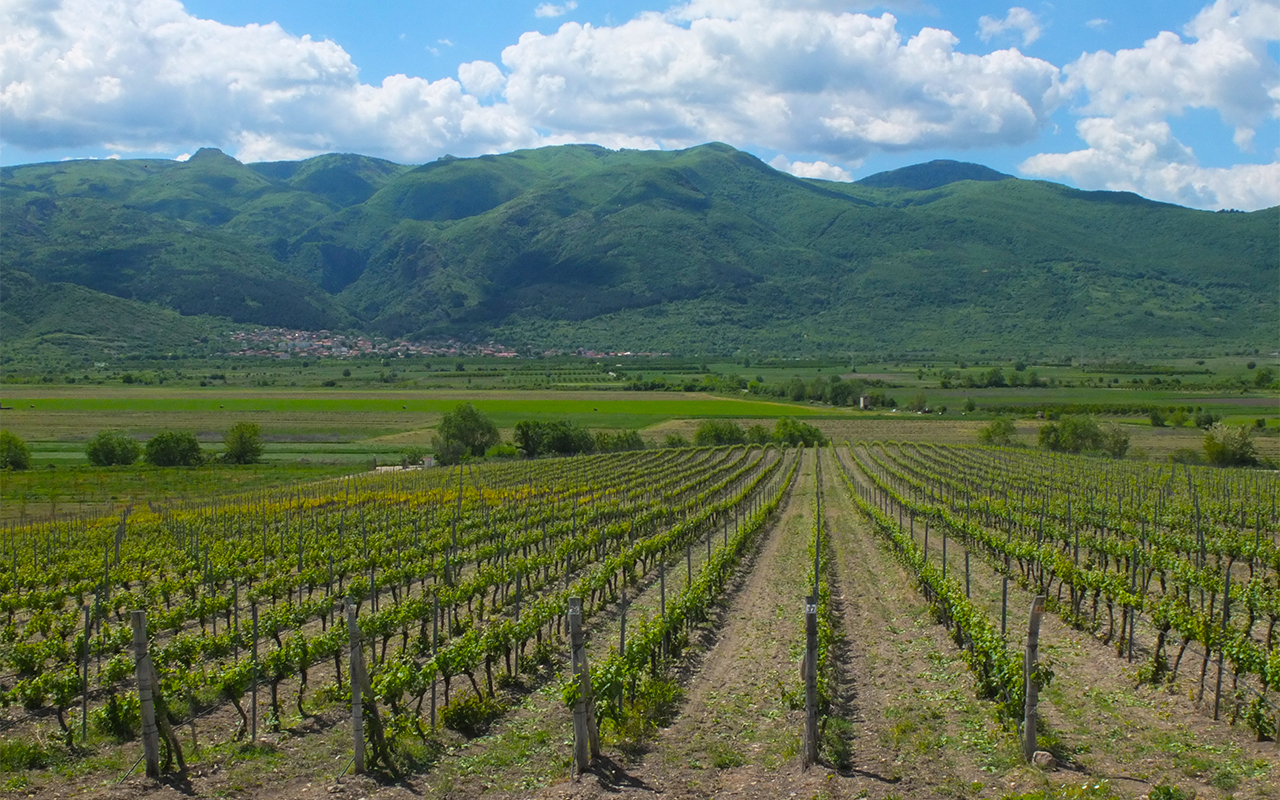VIOGNIER DOWN-UNDER

By Rose Murray Brown MW Published in The Scotsman 23 May 2020
“Viognier is a white wine for people who prefer reds”, says Louisa Rose, head winemaker at Yalumba in Eden Valley in South Australia. “Tastewise, it has such a lush succulent texture and low acidity similar to reds”.
Ask any wine producer down-under about the Viognier grape and they will always refer back to the ‘Queen of Viognier’, Louisa Rose. She took the variety under her wing when she joined Yalumba nearly 30 years ago – and today produces Australia’s best examples of this grape.
Unlike Grenache and Shiraz which had been growing in Australia since C19, Viognier is a relatively new thing for Australia. Rose told me about her struggle with this tricky grape, during a virtual tasting she conducted recently from her South Australia base.
“I first came across Viognier when I arrived at Yalumba in 1992”, says Rose. “Even at Roseworthy, Australia’s leading oenology college, I had never encountered Viognier – as at that time there was still little planted even in its homeland in Condrieu in France’s northern Rhone”.
 Yalumba’s first commercial plantings of Viognier had been back in 1980, so by the time Rose arrived the vines had started to settle down. But, she admits, it took her a while to get to grips with this strange variety – it behaved so differently to other grapes (pictured Yalumba's Eden Valley vineyard).
Yalumba’s first commercial plantings of Viognier had been back in 1980, so by the time Rose arrived the vines had started to settle down. But, she admits, it took her a while to get to grips with this strange variety – it behaved so differently to other grapes (pictured Yalumba's Eden Valley vineyard).
“We made a lot of mistakes, we picked it too early at the same time as Riesling and made wines with no flavour at all. The next vintage we picked later at a similar time to Shiraz”, she says. “Even in the vineyard Viognier behaves like a red wine. It likes to get sunburnt, wrinkly and shrivel up, which is more of a red grape trait”.
In the winery, she turned everything on its head. She used no skin contact as Viognier has such high phenolics (natural chemical compounds including tannins and anthocyanins) – with too much skin contact you just get bitterness. For Viognier she also used no additives, no cultured yeasts, no chilling – just pressed the grapes straight to the fermenting tank.
“The must in early fermentation is really dark brown, but eventually phenolics fall out and beautiful clear green wine comes out”, she says.
“I have always used wild native yeasts for Viognier to give more complexity, integrated alcohol and balance. One of the most important things about Viognier is balance”, she says. “It’s a naturally low acid grape, but it does have refreshing bitterness from phenolics that come out of the skins. These white tannins are an important part of the structure of Viognier – and much better than adding acid”.
One of Viognier’s great traits is its wonderful heady aromas. Spice, floral, apricot and peach and on the palate and in Australian examples it has a softness and sweetness because of its low acidity, making the unoaked examples so approachable. Rose agrees that Viognier is at its most beautiful and vibrant as a young wine, not many people age it – apart from her.
In my own experience with tasting groups, it is not a grape that appeals to everyone, but it is incredibly food friendly as it can manage sophisticated flavours.
“My favourite is serving Viognier with Morrocan-style tagine”, says Rose. She also recommends sweet-sour dishes, beef rendang, pan fried herb mushrooms, chilli and salad, Thai food or even mild Korma curry. Richness and spice in wines bring out the flavours and textures in food.
Wine lovers might also have encountered Viognier on a label in a red Shiraz blend. This is a traditional idea, originally from the northern Rhone valley’s Cote Rotie, when a small percentage of Viognier is added during fermentation to lift aromatics of the Shiraz. At Yalumba, Rose has also been experimenting with this, but has found that adding 5% Viognier to her Shiraz is too much – so has reduced to 2% Viognier addition in the red blend.
Looking to the future, Rose reckons that Viognier is going to be able to cope well with Australia’s increasingly warm summers, as it likes dry conditions. “We also love experimenting with new varieties – those showing good potential are Tempranillo and Albarino in Australia”, she says. “My own money is on Spain’s Verdejo grape which we recently planted, which gives freshness, zestiness and vibrancy even in a hot climate”.
Viognier is still her favourite. So much so that she has even designed her own glass to enjoy her premium Virgilius. “The ideal Viognier glass has a big bowl and closed at the top to capture the grape’s wonderful heady aromas”, she says.
THREE FACES OF VIOGNIER
(all screwcapped & vegan friendly):
 Y SERIES VIOGNIER 2019 Yalumba (13.5%) ***STAR VALUE***
Y SERIES VIOGNIER 2019 Yalumba (13.5%) ***STAR VALUE***
£8 Majestic Wine; Morrisons, Sainsburys, Marks & Spencer; Co-op
The backbone of this blend is from irrigated vineyards in warmer Murray River, but Rose also blends in cooler vineyard sites from unirrigated sites in Barossa Valley and Adelaide Hills to add freshness. This unoaked dry Viognier has barely 2 g/l residual sugar, but it has a sweet-sour note typical of the grape. Heady aromas of orange blossom with fresh pineapple flavours, figgy notes and lovely silky smooth texture.
 ORGANIC VIOGNIER 2019 Yalumba (13.5%)
ORGANIC VIOGNIER 2019 Yalumba (13.5%)
£10 Tesco; Waitrose; Aitken Wines
All grapes for this organic Viognier come from warmer Murray River in Riverland region, where one of Yalumba’s growers decided to go for organic certification and proved successful. Herby fennel notes, saline undertones and a juicy earthiness with a touch of leesy richness. Despite its warm location, this unoaked Viognier is more savoury than the Y series.
 THE VIRGILIUS 2017 Yalumba (13.5%)
THE VIRGILIUS 2017 Yalumba (13.5%)
£30 Amazon
Only 400 cases made of flagship Viognier; a very different beast from old vines in cool elevated Eden Valley. It has barrel fermentation flavours and leesy richness, with sleekness, elegance and long finish – but is more savoury restrained and tightly wound. Unusually for Viognier this will improve with a few years in bottle, to enable the stone fruits and spiciness to come to the fore.
Join Rose’s virtual wine tastings: ‘Meet the Winemakers’ on Fridays 12 & 19 June with Raeburn Fine Wines www.rosemurraybrown.com
wine tastings
The perfect gift for the wine enthusiast in the family. Rose does In-person tastings too.
cellar advice
Rose does cellar valuations for private clients, valuations for insurers & bespoke portfolio management.
Related stories
April 6, 2024
By Rose Murray Brown MW Published in The Scotsman 6 April 2024 Bulgaria was one of the first countries in the modern wine world to sell its wines by varietal labelling – with the grape name clearly emblazoned on the front label - a practice which was swiftly taken up by the New World countries. Back in early 1990s
March 31, 2024
By Rose Murray Brown MW Published in The Scotsman 30 March 2024 On 2 February 1659, the first wine made from grapes grown in South Africa was crafted by the Governor of the Cape, Jan van Riebeeck. He had planted vines four years earlier in the Company’s Garden near Cape Town from cuttings imported from France. Van Riebeeck’s first
March 24, 2024
By Rose Murray Brown MW Published in The Scotsman 16 March 2024 Heatwaves and bushfires were very much on the agenda when I visited Chile last month as winemakers prepared for their 2024 harvest in blistering heat and drought, with a plume of smoke from the devastating fires lingering over coastal hills. Heat and drought are the greatest challenges



